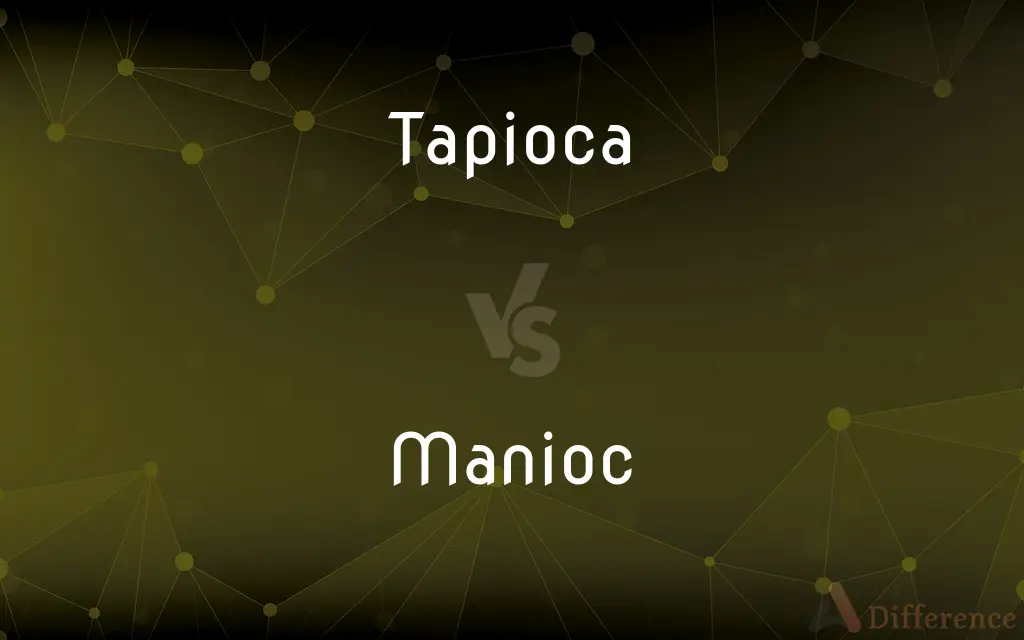Tapioca vs. Manioc — What's the Difference?
By Tayyaba Rehman & Fiza Rafique — Updated on April 26, 2024
Tapioca is a starch extracted from manioc roots, used in puddings and boba, while manioc, also known as cassava, is the root itself.

Difference Between Tapioca and Manioc
Table of Contents
ADVERTISEMENT
Key Differences
Tapioca is a processed product derived from the roots of the manioc plant, primarily used as a food thickener and in dishes like tapioca pudding and boba tea. Whereas manioc, also known as cassava, is a tropical root vegetable that can be cooked and eaten whole like potatoes or processed into products like flour and tapioca.
The production of tapioca involves extracting starch from the crushed manioc root, which is then turned into pearls, flakes, or flour. On the other hand, manioc as a whole can be boiled, baked, or fried, making it a versatile ingredient in many global cuisines, especially in Africa and Latin America.
Tapioca is valued for its neutral flavor and gelatinous texture, making it a popular thickening agent in both sweet and savory dishes. Conversely, manioc has a distinct flavor, somewhat nutty when cooked, and requires careful preparation to remove natural toxins found in raw forms.
Nutritionally, tapioca is almost pure carbohydrate with very little protein, fiber, or nutrients, since it is just the starch from the manioc root. Manioc itself is more nutritious, providing a significant source of carbohydrates, vitamin C, and calcium, but it also needs to be prepared properly to avoid toxicity.
Culturally, tapioca has found a place in various forms around the world, from the pearls in Asian desserts to the flour in Brazilian cheese bread. Manioc remains a staple food in many tropical regions, essential for its adaptability to poor soil conditions and its caloric value.
ADVERTISEMENT
Comparison Chart
Definition
Starch extracted from manioc
Tropical root vegetable
Use
Thickener, sweets, boba tea
Eaten whole, flours
Preparation
Processed from manioc starch
Boiled, baked, fried
Flavor
Neutral, absorbs other flavors
Nutty when cooked
Nutritional Value
Low in nutrients, high in carbs
Higher in vitamins, fiber
Compare with Definitions
Tapioca
A starch extracted from the root of the manioc plant, used in cooking.
Tapioca pearls are essential for making traditional boba tea.
Manioc
Can be toxic if eaten raw due to the presence of cyanogenic glycosides.
Manioc must be properly cooked to ensure it is safe to eat.
Tapioca
Processed into various forms like pearls, flakes, or flour.
She used tapioca flour to thicken her fruit pie filling.
Manioc
Staple food in many tropical and subtropical regions.
In Nigeria, manioc is a major source of carbohydrates.
Tapioca
Popular as a gluten-free alternative to wheat-based products.
Tapioca bread is a great option for those with gluten intolerance.
Manioc
Also known as cassava, a root vegetable native to South America.
Manioc is extensively cultivated in Brazil for both domestic use and export.
Tapioca
Known for its chewy texture in puddings and desserts.
Tapioca pudding is a favorite dessert because of its unique texture.
Manioc
Used to make tapioca and a gluten-free flour alternative.
Manioc flour is commonly used in Brazilian recipes like pão de queijo.
Tapioca
Contains mostly carbohydrates, with minimal protein or fiber.
Tapioca is often added to meals to boost carbohydrate intake.
Manioc
Richer in nutrients compared to its derivative, tapioca.
Manioc provides more dietary fiber and vitamin C than tapioca.
Tapioca
Tapioca (; Portuguese: [tapiˈɔkɐ]) is a starch extracted from the storage roots of the cassava plant (Manihot esculenta, also known as manioc), a species native to the north and central-west regions of Brazil, but whose use is now spread throughout South America. The plant was brought by the Portuguese to much of West Indies, Africa and Asia.
Manioc
See cassava.
Tapioca
A starch made from cassava roots, usually processed as beads or flakes and used for puddings and as a thickening agent in cooking.
Manioc
The tropical plant Manihot esculenta, from which cassava and tapioca are prepared.
Tapioca
A dish, especially a pudding, made from this starch.
Manioc
(uncountable) Cassava root, eaten as a food.
Tapioca
A starchy food made from the cassava plant, used in puddings.
Manioc
(uncountable) A food starch prepared from the root.
Tapioca
The cassava plant, Manihot esculenta, from which tapioca is derived; manioc.
Manioc
The tropical plants (Manihot utilissima, and Manihot Aipi), from which cassava and tapioca are prepared; also, cassava.
Tapioca
A coarsely granular substance obtained by heating, and thus partly changing, the moistened starch obtained from the roots of the cassava. It is much used in puddings and as a thickening for soups. See Cassava.
Manioc
A starch made by leaching and drying the root of the cassava plant; the source of tapioca; a staple food in the tropics
Tapioca
Granular preparation of cassava starch used to thicken especially puddings
Manioc
Cassava root eaten as a staple food after drying and leaching; source of tapioca
Manioc
Cassava with long tuberous edible roots and soft brittle stems; used especially to make cassiri (an intoxicating drink) and tapioca
Common Curiosities
How is manioc used?
Manioc, or cassava, can be boiled, baked, or turned into flour and used in various dishes.
What are the health benefits of manioc?
Manioc is a good source of carbohydrates and energy, especially in regions where other crops are difficult to cultivate.
Can you eat manioc raw?
Manioc should not be eaten raw due to the presence of cyanide; it must be cooked properly.
How can tapioca be used in a gluten-free diet?
Tapioca flour is excellent for baking and as a thickener in various gluten-free recipes.
How is tapioca processed from manioc?
The manioc root is grated and washed to extract the starch, which is then processed into tapioca.
What is tapioca?
Tapioca is a starch extracted from the cassava plant, used as a food thickener and in desserts.
Are tapioca and manioc the same?
Tapioca is a derivative of manioc; it is the starch extracted from the manioc root.
How do tapioca and manioc differ in taste?
Tapioca has a neutral taste, whereas manioc has a more distinct, slightly nutty flavor.
Is tapioca gluten-free?
Yes, tapioca is naturally gluten-free and often used in gluten-free recipes.
What dishes can you make with tapioca?
Tapioca is used in puddings, boba tea, and as a thickener in pies and soups.
What is the nutritional value of manioc?
Manioc is high in carbohydrates and provides essential vitamins like vitamin C and minerals.
What are the differences in using tapioca vs. manioc in recipes?
Tapioca is best for thickening and adding texture, while manioc is better suited for direct consumption and as a source of carbohydrates.
Where is manioc commonly grown?
Manioc is primarily grown in tropical and subtropical regions, including parts of Africa, Asia, and South America.
What are some safety tips for preparing manioc?
Always peel and cook manioc thoroughly to eliminate any harmful toxins.
Are there any risks associated with consuming manioc?
If not prepared correctly, manioc can retain cyanide, which is toxic, so proper cooking is essential.
Share Your Discovery

Previous Comparison
Consequence vs. Ramification
Next Comparison
Thing vs. ObjectAuthor Spotlight
Written by
Tayyaba RehmanTayyaba Rehman is a distinguished writer, currently serving as a primary contributor to askdifference.com. As a researcher in semantics and etymology, Tayyaba's passion for the complexity of languages and their distinctions has found a perfect home on the platform. Tayyaba delves into the intricacies of language, distinguishing between commonly confused words and phrases, thereby providing clarity for readers worldwide.
Co-written by
Fiza RafiqueFiza Rafique is a skilled content writer at AskDifference.com, where she meticulously refines and enhances written pieces. Drawing from her vast editorial expertise, Fiza ensures clarity, accuracy, and precision in every article. Passionate about language, she continually seeks to elevate the quality of content for readers worldwide.














































